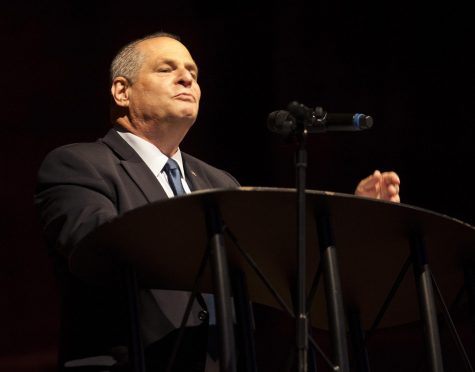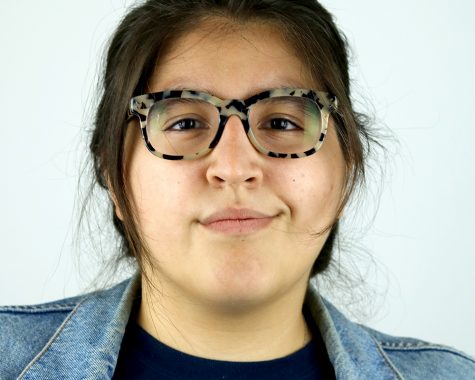Dual credit increases at Eastern
October 6, 2019
Editor’s note: The News wanted to run this story as a sidebar to our initial story about the State of the University Address in Friday’s edition of The Daily Eastern News. In this story we explain the enrollment aspect of Eastern President David Glassman’s speech including what he said about enrollment increasing and dual-credit courses.
Eastern President David Glassman, aside from highlighting increases in enrollment, also talked about the benefit of dual-credit courses for Eastern during his State of the University Address Thursday.

Eastern President David Glassman delivered his State of the University address at the Doudna Fine Arts Center Thursday afternoon.
Dual Credit Potential
Eastern’s overall enrollment was up 3.7 percent this year with 7,806 students enrolled.
That number includes full-time and part-time undergraduate and graduate students as well as high school students taking dual-credit courses.
To break the numbers down even further there are 1,580 high school dual credit students, 4,649 undergraduate students (full time and part time) and 1,577 graduate students (full time and part time), according to Tenth Day Enrollment data.
There are 4,917 total students on campus, which is down by 3.25 percent compared to last year, according to the data.
This year high school dual credit enrollment increased from 1,274 in Fall 2018 to 1,577 in Fall 2019.
Glassman said Eastern is partnered with a select group of high schools to offer dual credit courses to students at those schools.
He said these partnerships, which use a unique educational model, have been so successful that other school districts have been approaching Eastern requesting they be added to the partner list.
For example, this year Eastern added a partnership with Lake Zurich to teach a Spanish class and with Maine Township to teach math classes.
Glassman said the university does not anticipate adding any additional partnerships for next year.
Glassman said college-bound high school students taking dual-credit courses has become a “national norm” because of reduced college costs and accelerated completion rates.
He said Eastern’s dual-credit initiative is valuable and strategic and more universities are leveraging the emerging opportunity to expand partnerships as a way to diversify traditional revenue streams.
“How far Eastern should or will venture into the dual credit arena will depend on the positive outcomes it presents to Eastern as a partner provider,” Glassman said.
Some of these “positive outcomes” include the possibility of those high school students attending Eastern.
Paul McCann, the interim vice president of business affairs, said dual credit is important to the university because it represents potential future revenue.
“It is not significant from the standpoint of the revenue that it produces today or the expenses that we have to incur to do it,” McCann said.
Glassman said dual-credit connections offer an onramp for high school students to continue their higher education journey as on-campus undergraduates at their affiliate institutions. That includes Eastern.
According to Tenth Day data, high school dual-credit numbers appeared on the data as early as Fall 2018.
McCann said there really was not a start date as to when Eastern started counting dual-credit courses but said when the community colleges were solely doing dual-credit, they were required by the Illinois Board of Higher Education to report those numbers.
“When we moved into the space of allowing for dual credit, the IBHE said, ‘you guys should do it the same way that the community colleges do and include it as part of your enrollment,’” McCann said.
He said Eastern’s approach to offering dual-credit courses is unique and the numbers have been very good.
“Not every four-year institution has gotten into that space (of high dual credit),” McCann said.
Josh Reinhardt, Eastern’s public information coordinator, said since Eastern has only gotten into the dual credit market “a few years ago” they will start seeing some of those numbers soon.
McCann said there is a small return on those dual-credit enrolled students right now but focusing on that number will increase it in the future.
Other Enrollment Highlights
The overall number of new transfer students fell this year by 32 students while first time, full-time freshman enrollment increased 12.5 percent this year.
“We did notice an interesting occurrence in the number of undergraduate students who chose to transfer to Eastern from other four-year universities in Illinois and out-of-state,” Glassman said. “This group increased by 50 percent, an outcome that suggests our brand is strengthening in the marketplace and that a number of students came to realize Eastern should have been their first-choice option.”
First-time full-time freshmen living within a 60-mile radius of the university also increased by 48 percent this year and the freshman class has a 3.2 average GPA, which is slightly higher than last year’s class.
Graduate student enrollment increased by 4.2 percent and Glassman said this is the largest number Eastern has seen since Fall 2010.
“This number would have been appreciably higher had it not been for the difficulties several of our accepted international students encountered in navigating the current federal policies and practices guiding immigration,” Glassman said.
International student enrollment increased by 3 percent with 332 students representing 61 countries. Glassman said this is the largest number of countries Eastern has ever had represented on campus at one time.
Analicia Haynes can be reached at 581-2812 or achaynes@eiu.edu.


















![[Thumbnail Edition] Senior Foward Macy McGlone, getsw the ball and gets the point during the first half of the game aginst Western Illinois University,, Eastern Illinois University Lost to Western Illinois University Thursday March 6 20205, 78-75 EIU lost making it the end of their season](https://www.dailyeasternnews.com/wp-content/uploads/2025/03/WBB_OVC_03_O-1-e1743361637111-1200x614.jpg)

















































